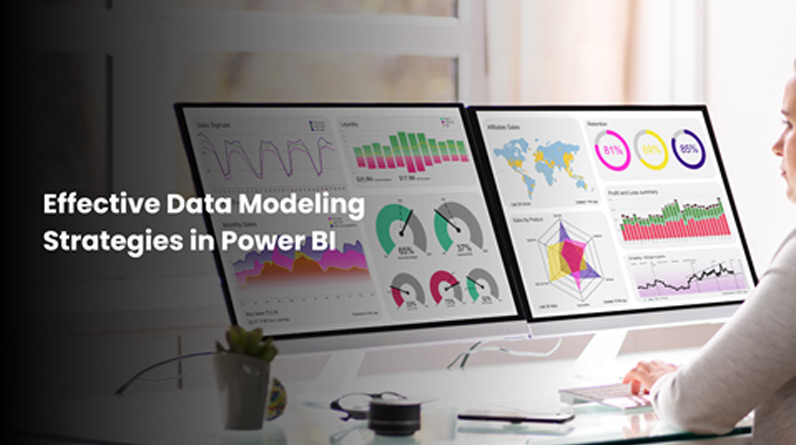Data has become the lifeblood of modern businesses, driving informed decision-making and enabling organisations to gain a competitive edge. Power BI is a versatile and powerful business intelligence tool developed by Microsoft, empowers users to transform raw data into actionable insights. Whether you’re preparing for the PL300 Certification or just getting started with Power BI, understanding effective data modelling strategies is crucial. In this blog, we will understand What is Power BI and explore the fundamentals of data modelling in Power BI. Gaining insight into advanced techniques that provide valuable insights to help you excel in your data visualisation journey.
Table of contents
- What is Power BI?
- The Importance of Data Modeling
- Key Data Modeling Concepts
- Effective Data Modeling Strategies
- Advanced Data Modeling Techniques
- Testing and Iteration
- Conclusion
What is Power BI?
Power BI is a versatile and powerful business intelligence and data visualization tool allowing users to connect to diverse data sources, transform data, create dynamic reports, and share insights. It offers a range of features such as data importing, data modelling, DAX (Data Analysis Expressions) calculations, and stunning visualisations to make data-driven decision-making accessible to everyone.
The Importance of Data Modeling
Data modeling is the process of structuring data to make it easier to analyse and visualise. In Power BI, effective data modeling is the cornerstone of creating meaningful reports and dashboards. Here’s why it matters:
- Enhanced Performance: Efficient data models optimise query performance, ensuring that your reports load quickly and respond to user interactions in real-time. This is particularly important for achieving the PL300 Certification, where performance optimisation is a key criterion.
- Simplified Analysis: A well-structured data model simplifies the process of exploring data, enabling users to drill down into details, filter data, and gain deeper insights with ease.
- Scalability: As your organisation’s data grows, a well-designed data model ensures scalability, allowing you to integrate new data sources and adapt to changing business needs seamlessly.
Key Data Modeling Concepts
To excel in Power BI and achieve the PL300 Certification, it’s crucial to grasp some fundamental data modeling concepts:
- Data Sources: Power BI can connect to a variety of data sources, including databases, Excel files, online services, and more. Choose the appropriate data source and ensure data quality before importing.
- Relationships: Establishing relationships between tables is at the heart of data modeling. Understand the different types of relationships, such as one-to-one, one-to-many, and many-to-many, and how they impact your data model.
- Measures and Calculated Columns: Learn how to create measures and calculated columns using DAX. Measures are dynamic calculations that respond to user interactions, while calculated columns are pre-computed values.
Effective Data Modeling Strategies
let’s explore some effective data modeling strategies to help you excel in Power BI:
- Start with a Clear Data Model Design: Before importing data, plan your data model’s structure. Identify key tables and their relationships to ensure a logical and efficient design.
- Optimise Data Loading: Use Power Query Editor to clean and transform data before loading it into Power BI. Remove unnecessary columns, handle null values, and apply data type conversions to enhance data quality.
- Create Hierarchies: Hierarchies simplify navigation for users. Create hierarchies in your data model to allow users to drill down into data effortlessly.
- Master DAX Calculations: Understanding DAX is essential for creating powerful calculations. Practice writing complex DAX formulas to compute key metrics and KPIs.
Advanced Data Modeling Techniques
To truly excel in Power BI and stand out in the PL300 Certification, consider implementing these advanced data modeling techniques:
- Aggregations: Optimise query performance by using aggregations to pre-calculate and store summarised data at different granularity levels.
- Advanced Relationships: Explore advanced relationship techniques like bidirectional filtering and role-playing dimensions to handle complex data scenarios.
- Time Intelligence: Leverage DAX functions for time-based calculations, such as year-to-date, month-to-date, and rolling averages, to gain deeper insights into your data.
Testing and Iteration
Successful data modeling in Power BI often involves a cycle of testing and iteration. Regularly review your data model, gather feedback from users, and refine your design to ensure it meets evolving business needs.
Conclusion
Power BI is a powerful tool in data analytics and business intelligence that opens possibilities for organisations and individuals. Effective data modelling strategies, as discussed in this blog, are essential for harnessing the full potential of Power BI. Whether pursuing the PL300 Certification or simply aiming to become a proficient Power BI user, mastering data modelling will set you on the path to success. Embrace the concepts and techniques outlined here and watch as your data transforms into actionable insights that drive informed decision-making.


